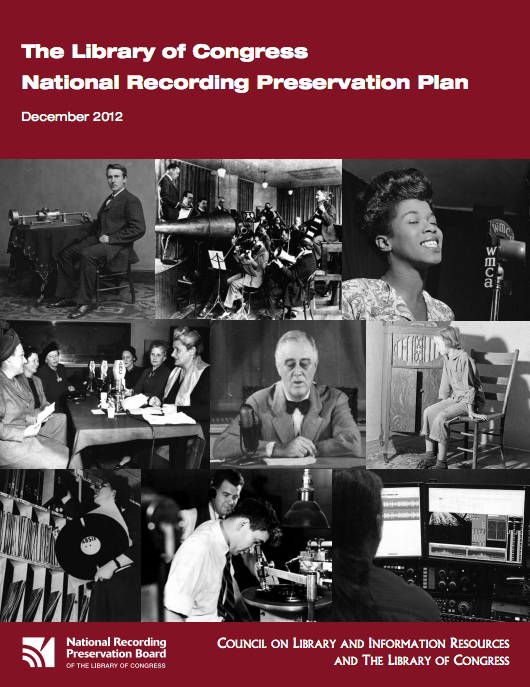NRPF’s mission is to coordinate resources in order to support, promote, and preserve recorded sound history. In that spirit, we aim to provide data about the preservation needs and current state of recorded sound collections in the United States. This data may inform policy and priorities that can advance the preservation of and access to significant audio recordings.
Read below about some of the notable resources.
Audio Preservation Reports
The following reports were created by related efforts, in collaboration with or with the support of the NRPF, or issued by affiliated organizations.
ARSC Guide to Audio Preservation
The “Guide to Audio Preservation” is a co-publication of ARSC (Association for Recorded Sound Collections), CLIR (Council on Library and Information Resources) and the Library of Congress, it was made possible through funding from the Recording Board, along with contributions from CLIR and an anonymous donor. This 200+ page publication is a primer for the non-specialist (collectors, archivists at universities, libraries and historical societies) to help them manage their collections of audio recordings.
Access the full report here: https://www.clir.org/pubs/reports/pub164/.
National Recoring Preservation Plan
 The National Recording Preservation Plan was devised to provide a blueprint to “implement a comprehensive national sound recording preservation program,” as mandated in the National Recording Preservation Act of 2000. The goal of the study was to raise public and private recognition of the importance of recorded sound preservation by developing a comprehensive national recording preservation program. In addition, the program would allow the Library, in consultation with the National Recording Preservation Board, to identify initiatives to help solve the challenges faced by the various stakeholders. The plan spells out 32 short- and long-term recommendations involving both the public and private sectors and covering infrastructure, preservation, access, education and policy strategies.
The National Recording Preservation Plan was devised to provide a blueprint to “implement a comprehensive national sound recording preservation program,” as mandated in the National Recording Preservation Act of 2000. The goal of the study was to raise public and private recognition of the importance of recorded sound preservation by developing a comprehensive national recording preservation program. In addition, the program would allow the Library, in consultation with the National Recording Preservation Board, to identify initiatives to help solve the challenges faced by the various stakeholders. The plan spells out 32 short- and long-term recommendations involving both the public and private sectors and covering infrastructure, preservation, access, education and policy strategies.
Learn about the National Recording Preservation Plan at the Library of Congress’ website: https://www.loc.gov/programs/national-recording-preservation-plan/.
Quantifying the Need
In 2014, AVPreserve and the Northeast Document Conservation Center (NEDCC), with funding from The Andrew W. Mellon Foundation, undertook an in-depth, multi-faceted assessment to quantify the existing audio items held in institutional collections throughout the United States. This was performed in response to The Library of Congress National Recording Preservation Plan and its call for the appraisal of collections, as well as to establish a foundation for articulating the current preservation need of sound recordings in collections nationwide. The research found that there are over 537 million sound recordings in collection-holding organizations across the US, grooved media and magnetic media (largely reel-to-reel tape) were the most widely held formats, and the largest quantity of sound recorded is held by academic libraries, archives, and museums. Nearly sixty percent of these are estimated to be unique or rare while less than twenty percent have already been digitized. The report determined that nearly 250 million of the extant recordings are “preservation-worthy” (unique, rare, or irreplaceable), and approximately seventy percent can be digitized using standard preservation workflows. Nonetheless, the cost of digitizing all of these items would be over $20 billion (US dollars).
Read the full report at AVP’s website: https://www.weareavp.com/quantifying-the-need-a-survey-of-existing-sound-recordings-in-collections-in-the-united-states/.
NRPF’s Contributions
In addition to making preservation grants, we strive to support work that leads to the better understanding of the state of audio preservation in the United States. For example, in 2018 and again in 2023, we supported critical work to survey the extent of recordings and preservation needs in the broadcast archives of Historically Black Colleges and University radio stations. As project director Jocelyn Robinson stated, “we won’t know what needs preservation until we survey the content and conditions of the radio archives on HBCU campuses. What we discover could have enormous potential for podcasts, radio and film documentaries, and museum exhibitions, allowing students, researchers, media producers, and communities to remember, honor and be inspired by the voices of this important legacy.”
“We won’t know what needs preservation until we survey the content and conditions of collections in need.”
—Jocelyn Robinson, project director for the Survey of Broadcast Archives of Historically Black Colleges & Universities
NRPF aims to provide, summarize, and create useful background information to inform decision makers and funders regarding responsive, best-practice approaches to preservation challenges that confront the audio preservation community. This guidance touches on many aspects of recorded sound preservation, from work with vintage format types to the stories and communities whose perspectives are recorded in these sounds.




